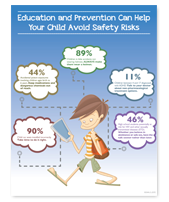A Lot to Think About
There’s a Lot to Think About
Keeping our kids healthy and safe is a full-time job no matter how old they may be. We all have to deal with the bumps and scrapes they inevitably experience. And there is no way to keep them from ever getting sick, but education and prevention can help minimize the risks for illness and injury. Here are some tips to help you keep track of what you need to do.
Help Your Child Develop Healthy Eating Habits
Offer your kids nutritious meals and snacks with an appropriate number of calories. They will develop healthy eating habits. Remember, they need:
- Plenty of vegetables, fruits and whole-grain products.
- Low-fat or non-fat milk or dairy products.
- Lean meats, poultry, fish, lentils and beans for protein.
- Reasonably sized portions.
- Lots of water.
Cut Back on Screen Time
Limit time spent watching TV, playing video games and surfing the Internet to no more than two hours a day. The American Academy of Pediatrics doesn’t recommend TV for kids ages 2 or younger. Encourage your children to find fun activities to do with family members or on their own. The American Academy of Pediatrics is an independent organization that offers health information on behalf of your health plan.
Help Your Kid Stay Active
Getting away from the screen can free up time for physical activity. Children and teens should participate in at least 60 minutes of moderate-intensity physical action most days of the week, and every day if possible. Some examples are:
- Playing tag
- Jumping rope
- Bike riding (Always with a helmet!)
- Swimming
- Dancing
Preventive Checkups and Immunizations
One of the best ways to keep your child healthy and safe is through preventive checkups. Seeing a doctor regularly can help make sure that any health problems are treated early, often before they develop into more serious conditions. Part of every preventive checkup should be a review of the immunizations that your child may need. There are specific immunizations that are needed at certain ages. Your child’s doctor or other health care professional can help you stay current on immunizations.
As your child moves into and through the teen years, exposure to potential harmful behaviors increases. Your child may have friends who use alcohol, tobacco and drugs, or engage in risky sexual behavior. Education is important to help you and your child avoid potential harmful outcomes. Make sure your child understands the harmful effects of drug, alcohol and tobacco use as well as the dangers of HIV and other sexually transmitted diseases.
Behavioral and Physical Health and Safety
Attention Deficit/Hyperactivity Disorder (ADHD)
Finding out that your child has ADHD is tough. The good news is that you are not alone. There are other parents in your situation, and teachers and caregivers who want what’s best for your child. There are also support groups where you can learn from those who have been dealing with ADHD longer than you.
You also need to know that medication is not the only treatment option available. Behavioral therapy has proven to reduce ADHD-related problems, especially if started soon after diagnosis. Setting routines, developing organization skills, limiting distractions, and using goals and rewards are some examples of non-medicinal treatments that can reduce the impact of ADHD. Talk to your child’s doctor about the treatment option that is best for your child.
Abuse and Neglect
ADHD is not the only reason for behavioral issues in children and teens. Be sure you are on the lookout for signs of physical, sexual and emotional abuse in your child no matter what age. Out of fear or shame, children and teens can become very good at hiding the pain of abuse. Here are some signs to watch for:
- Aggressive and anti-social behavior
- Decrease in academic achievement and school attendance
- Signs of malnourishment
- Incontinence and mysterious pains
- Slow physical development and coordination
- Depression, anxiety and low self-esteem
- Self-harm and suicidality
- Bedwetting, sleep problems, nightmares
- Eating problems, e.g., anorexia nervosa and bulimia nervosa
- Sexual behavior, language or knowledge too advanced for their age
If you notice these behaviors in your child (or other children), take action. The child may be unable to do anything about the abuse so it may be up to you to help. Find the number of your local child abuse hotline and call. You can remain anonymous if you desire and still intercede on behalf of a hurting child.
More Information
That’s a lot to think about! We want to help you in any way we can because it matters how you’re treated. If you have any questions about these topics or other health and safety issues with your child, see a health care professional or contact us.

